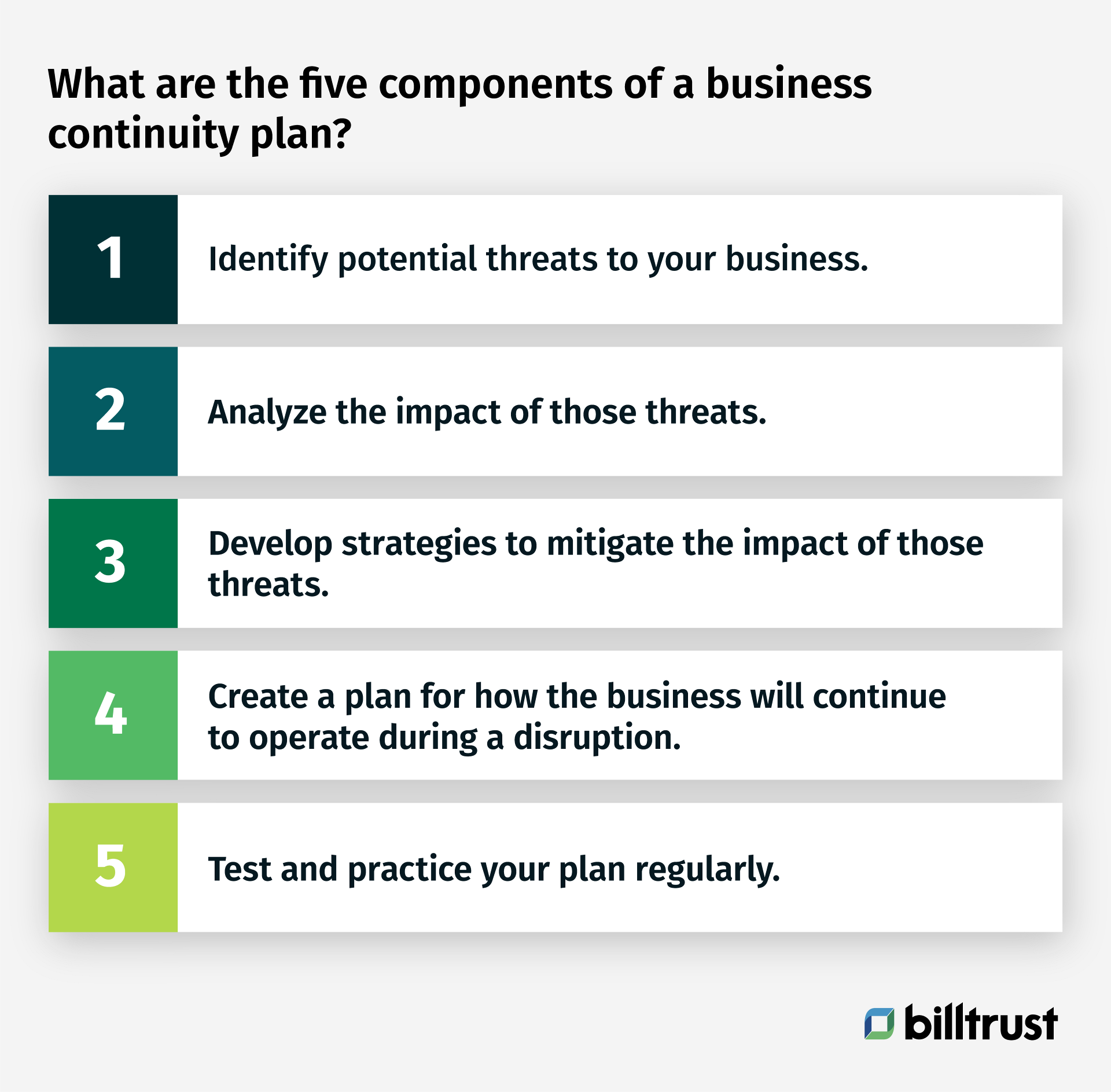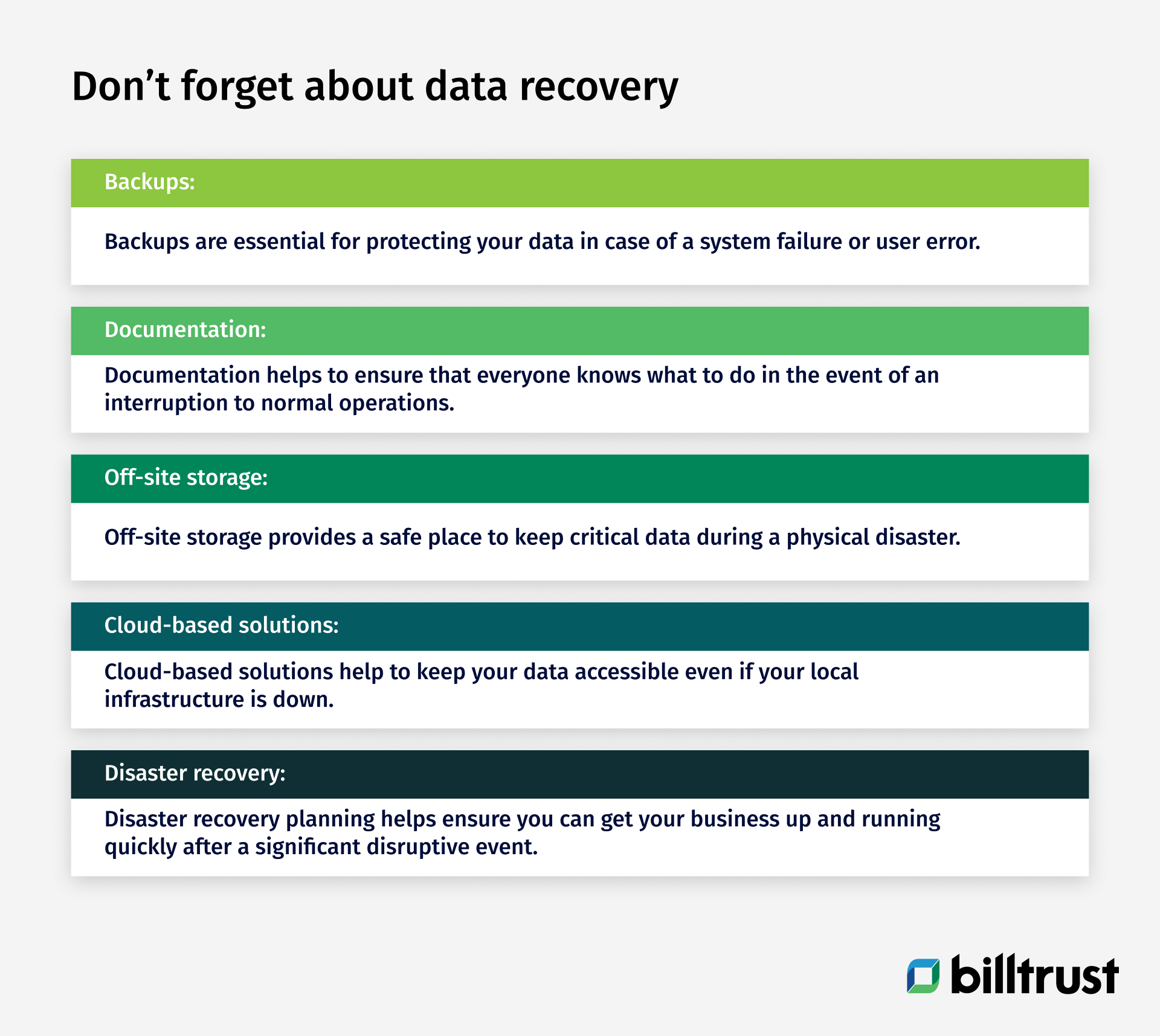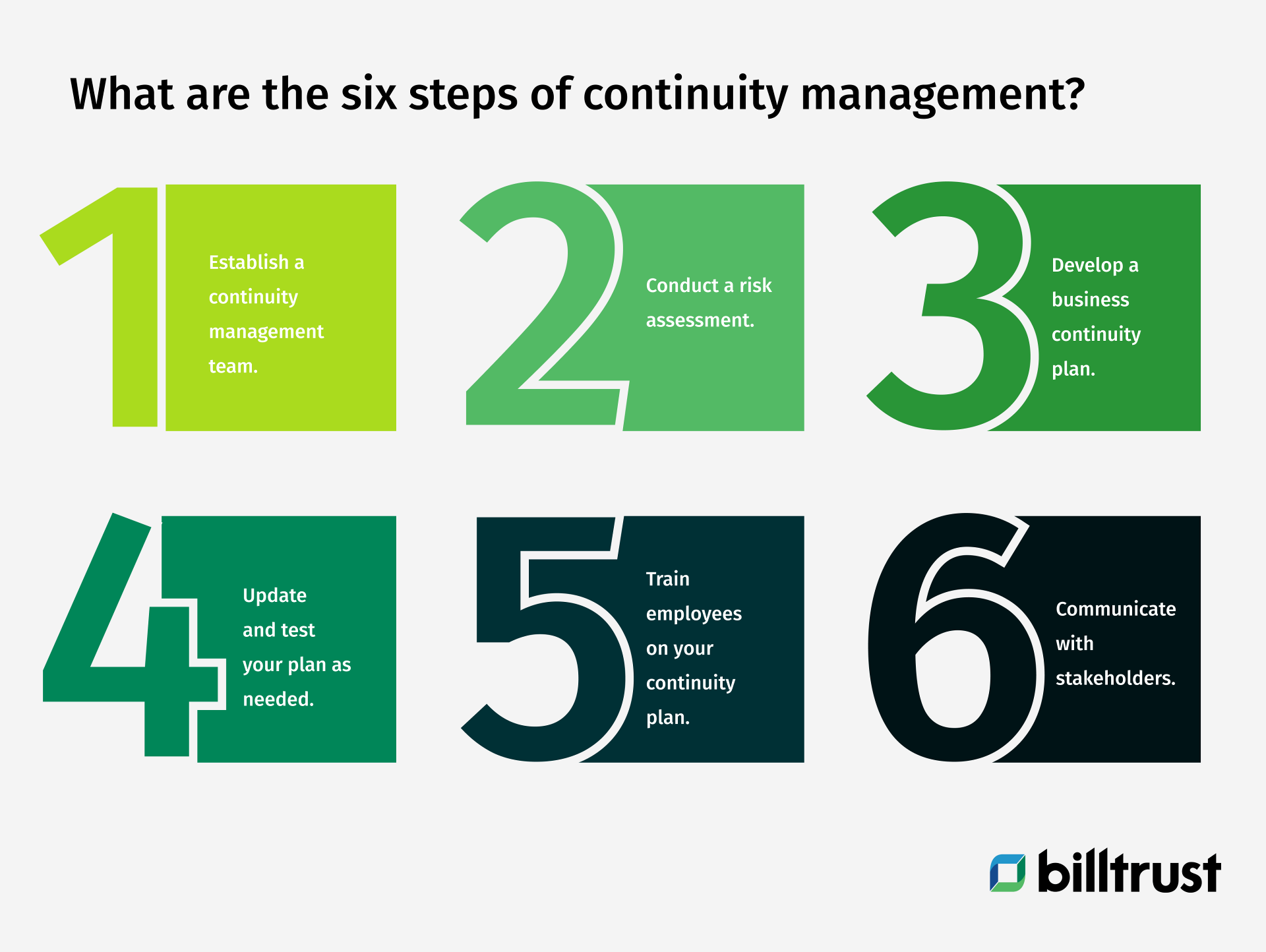As businesses, we know that disasters can (and will) happen.
The key is being prepared for them when they do. Creating a crisis continuity plan is one of the most critical steps in disaster preparation. A crisis continuity plan helps you outline how you will continue operations during a natural disaster, pandemic, supply chain disruption or other emergencies.
Creating a crisis continuity plan can seem daunting, but Billtrust is here to help. This guide will walk you through everything you need to know to create a comprehensive and effective program tailored to your business.
Why is continuity so important?
Imagine this: you're in the middle of a workday, and suddenly your power goes out—no lights, computer, or air conditioning. You and your accounts receivable team are left in the dark, wondering what to do next. This may sound like the beginning of a bad joke, but it's a real scenario that businesses worldwide face daily.
In today's fast-paced world, you must be able to adapt quickly to change. This is especially true in the wake of a disaster when companies must resume operations as soon as possible.
That's where business continuity comes in.
By developing a plan to keep operations running during and after an interruption, you can minimize the impact of disruptions and get back on track quickly.
Business continuity planning can often mean the difference between getting through a challenging situation and closing shop for good. Your plan will provide a clear blueprint for maintaining essential functions. In short, having a business continuity plan is no longer a luxury - it's a necessity.
In today's fast-paced world, you must be able to adapt quickly to change. This is especially true in the wake of a disaster when companies must resume operations as soon as possible.
The business continuity lifecycle and plan
The business continuity lifecycle is a never-ending identification, assessment, planning, implementation, testing and maintenance process. It's a lot like getting in shape - it's not something you can do once and forget about it. You have to keep at it to see results. And like getting in shape, business continuity planning (BCP) benefits are well worth the effort.
What is a business continuity plan?
A business continuity plan (BCP) is a plan to ensure your business can keep going even if something goes awry. In short, it’s an insurance policy for your company to ensure that your business can keep going even if things go wrong.
The most common reason businesses have a continuity plan is to protect against disasters, but there are other reasons too. For example, if you rely on a supplier who goes out of business, your continuity plan should include a way to find a new supplier. If you have a key employee who suddenly dies, your continuity plan should consist of a way to replace them.
So what should be in your continuity plan?
That depends on your business, but at a minimum, it should include a way to keep in touch with employees, customers and suppliers. You’ll also want to keep your website and other critical systems running and your cash flow in order. You’ll also want to be sure to digitize and automate as much of your operation as possible. If you're unsure where to start, plenty of resources are available online and from your local Chamber of Commerce.
The most important thing is to get started because the worst time to start planning for a disaster is when one is already underway.
What are the five components of a business continuity plan?
A business continuity plan is essential for any organization that wants to prepare for disruptive events. The five critical components of a business continuity plan are:

1. Identify potential threats to your business.
First, you need to identify the potential threats to your business. This includes things like natural disasters, power outages and data breaches.
2. Analyze the impact of those threats.
It would help if you analyzed the impact of those threats. What would be the financial cost of a data breach, for example? How long could your business survive without power? How robust is your cybersecurity?
3. Develop strategies to mitigate the impact of those threats.
Next, you can develop strategies to mitigate the impact of those threats. This might involve investing in backup generators, data security measures, mobile, cloud-based storage, and accepting email payments.
4. Create a plan for how the business will continue to operate during a disruption.
Next, you need to create a plan for how the business will continue to operate in the event of a disruption. This includes things like assigning roles and responsibilities and setting up communication plans.
5. Test and practice your plan regularly.
Finally, you must regularly test and practice your plan to ensure that it continues to fit your needs and that all key stakeholders continue to be well-versed in its execution.
Don't forget about data recovery
Additionally, you'll want to make plans for data recovery through five additional components:
- Backups: Backups are essential for protecting your data in case of a system failure or user error.
- Documentation: Documentation helps to ensure that everyone knows what to do in the event of an interruption to normal operations.
- Off-site storage: Off-site storage provides a safe place to keep critical data during a physical disaster.
- Cloud-based solutions: Cloud-based solutions help to keep your data accessible even if your local infrastructure is down.
- Disaster recovery: Disaster recovery planning helps ensure you can get your business up and running quickly after a significant disruptive event.
Each of these components is essential to a well-functioning business continuity plan. Without identifying potential threats, you cannot develop strategies to mitigate them. And without testing, you won't know if your program will work when you need it.

What are the six steps of continuity management?
While you want to prepare for the worst, it's important to remember that the best-laid plans often go awry. And why continuity management is essential for any organization that wants to survive unforeseen disasters.
But what exactly is continuity management?
Here are six steps to ensure you prepare your organization for anything:
- Establish a continuity management team. This team will have the responsibility of developing and implementing continuity plans.
- Conduct a risk assessment. This will help you identify potential threats to your organization and develop plans to mitigate those risks.
- Develop a business continuity plan. These plans should detail how your organization will continue functioning during an interruption.
- Update and test your plan as needed. As your organization changes, your continuity plan should be updated and tested. This is an excellent way to ensure you have all of the problems worked out.
- Train employees on your continuity plan. Employee buy-in is essential for effective continuity planning. Make sure everyone knows what to do in the event of an interruption.
- Communicate with stakeholders. Keep critical stakeholders updated on your progress and let them know what they can do to support continuity efforts.
Following these six steps, you can help prepare your organization for anything. Plus, your company may handle surviving post-pandemic with B2B ecommerce since your customers can buy items online.

Are you prepared to handle an accounts receivable (AR) crisis?
A business continuity plan is like a roadmap – it shows how your business will continue operating during and after an interruption or disaster.
By having a continuity plan in place, you can minimize the impact of an event on your business and ensure that essential operations can continue. It’s critical to update and test your plan regularly. That way, you can ensure its effectiveness when you need it the most.
So, what are you waiting for? Get started on your business continuity plan today.

